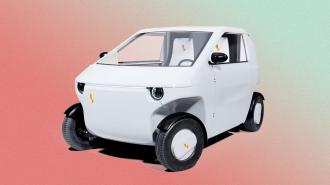Swedish startup Luvly is developing an ultra-efficient electric microcar — and like the furniture made by its compatriot Ikea, Luvly’s tiny EV will ship flat.
The challenge: Road transportation generates 15% of the world’s carbon emissions, making the transition from internal combustion engine (ICE) vehicles to EVs a key part of addressing climate change.
“Luvly O is a vehicle designed for the urban citizen, small but spacious and easy to charge.”
Joachim Nordwall
While EV sales are trending up, though, they still accounted for just 14% of the 75 million new passenger vehicles sold in 2022.
Worse, from an emissions perspective, 38% of the new units sold in 2022 were gas-powered SUVs. Bigger vehicles not only generate more emissions than sedans, they also take up more space in our increasingly crowded cities.
The microcar: Luvly has now unveiled the Luvly O, a microcar it hopes will appeal to drivers who’ve thus far avoided buying an EV due to concerns about cost and charging, while also saving space in cities.
“Luvly O is a vehicle designed for the urban citizen, small but spacious and easy to charge,” Joachim Nordwall, designer of the Luvly O, told Electric & Hybrid Vehicle Technology International.
The specs: The Luvly O is a two-seat “light urban vehicle” (LUV) with similar dimensions to an electric Smart Car. However, it weighs far less (837 pounds vs. 2,400 pounds), which helps it achieve the same range (62 miles) despite having a much smaller battery (6.4 kWh vs 17.6 kWh).
The microcar’s battery is also removable, meaning Luvly O owners won’t have to worry about finding and then killing time at charging stations — they’ll be able to take the battery out of the car and bring it into their homes to charge, or keep a spare on hand.
This process is made easier by a design that splits the battery into two units, each weighing 33 pounds. Charging each unit will take about two hours using one of the 120 volt outlets common in US homes, and about half as long using a standard European outlet.
“This technology offers by far the best-in-class passive safety.”
Luvly
While the Luvly O’s top speed of 56 mph is less than the Smart Car’s 80 mph, the EV should still be fast enough for most travel within cities, and what the microcar lacks in speed, it makes up for in price: Luvly plans to charge just $11,000 for a new vehicle.
The savings compared to some other microcars won’t come at the cost of safety, either, according to the company.
“LUVs are built like Formula 1 cars, with energy absorbers and a sandwich composite safety shell protecting the passengers,” writes Luvly, “This technology offers by far the best-in-class passive safety.”
EV microfactories: The specs alone are enough to make Luvly’s new microcar an intriguing addition to the world’s EV lineup, but the startup’s biggest innovation is likely its manufacturing process.
“We have actually developed a way to build light, safe vehicles that are cheap.”
Håkan Lutz
Rather than assembling the Luvly O in factories and then packing a few of the vehicles at a time into shipping containers for transport to customers, it’s designed a process that allows the parts of the vehicle to be packaged and shipped flat, similar to IKEA’s assemble-yourself furniture.
This allows Luvly to fit 20 cars’ worth of parts into a 20-foot shipping container.
The startup’s plan is to make the parts in one factory, then ship them flat to “microfactories” near customers for assembly. According to Luvly, it takes just a few hours to assemble one of the microcars — no welding or heavy machinery required.
Looking ahead: Luvly reportedly plans to release the Luvly O in 2023, but it’s not clear whether that means taking orders or actually making deliveries. In any case, the startup expects to kick off sales of the microcar in Stockholm first, followed by other European cities.
Ultimately, it hopes to license its manufacturing technology to other companies to make their own LUVs.
“We have actually developed a way to build light, safe vehicles that are cheap,” CEO Håkan Lutz told Swedish newspaper Dagens industri. “Exactly which vehicle you build on that platform is quite free.”
We’d love to hear from you! If you have a comment about this article or if you have a tip for a future Freethink story, please email us at tips@freethink.com.
